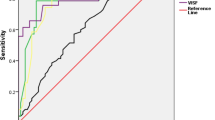Summary
The expression of resistin protein in normal human abdominal, thigh, pregnant women abdominal, non-pregnant women abdominal subcutaneous adipose tissue and placenta and the relationship between obesity, type 2 diabetes mellitus (T2DM), pregnant physiological insulin resistance (IR) and gestational diabetes mellitus (GDM) was investigated. The expression of resistin protein in normal human abdominal, thigh, pregnant women abdominal, non-pregnant women abdominal subcutaneous adipose tissue and placenta was detected by using Western blotting method. Fasting serum glucose concentration was measured by glucose oxidase assay. Serum cholesterol (CHOL), serum triglycerides (TG), serum HDL cholesterol (HDL-C) and serum LDL cholesterol (LDL-C) were determined by full automatic biochemical instrument. Fasting insulin was measured by enzyme immunoassay to calculate insulin resistance index (IRI). Height, weight, systolic blood pressure (SBP) and diastolic blood pressure (DBP) were measured to calculate body mass index (BMI) and body fat percentage (BF%). Resistin protein expression in pregnant women placental tissue (67 905±8441) (arbittary A values) was much higher than that in subcutaneous adipose tissue in pregnant women abdomen (40 718±3818,P<0.01), non-pregnant women abdomen (38 288±2084,P<0.01), normal human abdomen (39 421±6087,P<0.01) and thigh (14 942 ±6706,P<0.001) respectively. The resistin expression in abdominal subcutaneous adipose tissue showed no significant difference among pregnant, non-pregnant women and normal human, but much higher than that in thigh subcutaneous adipose tissue (P<0.001). Pearson analysis revealed that resistin protein was correlated with BMI (r=0.42), fasting insulin concentration (r=0.38), IRI (r=0.34), BF% (r=0.43) and fasting glucose (r=0.39), but not with blood pressure, CHOL, TG, HDL-C and LDL-C. It was suggested that resistin protein expression in human abdominal subcutaneous adipose tissue was much higher than that in human thigh subcutaneous adipose tissue. Resistin was closely related with central obesity, leading to IR, subsequently obesity and T2DM. Resistin protein expression in placental tissue was much higher than that in subcutaneous adipose tissue in normal human abdomen, pregnant abdomen, non-pregnant women abdomen and adipose tissue in normal human abdomen, pregnant abdomen, non-pregnant women abdomen and thigh. It was indicated that resistin protein could be secreted from human placental tissue. Resistin might be one of the factors that lead to pregnant physiological IR and GDM.
Similar content being viewed by others
References
Steppan C M, Baily S T, Bhat Set al. The hormone resistin links obesity to diabetes. Nature, 2001, 409 (6818):307–312
Moore G B T, Chapman H, Holder J Cet al. Differential regulation of adipocytokine mRNA by rosiglitazone in db/db mice. Biochem Biophys Res Common, 2001, 286(4):735–741
Catalano P M, Drago N M, Amini S B. Longitudinal changes in pancreatic beta-cell function and metabolic clearance rate of insulin in pregnant women with normal and abnormal glucose tolerance. Diabetes Care, 1998, 21(3):403–408
Yura S, Sagawa N, Ogawa Yet al. Augmentation of leptin synthesis and secretion through activation of protein kinases A and C in cultured human trophoblastic cells. J Clin Endocrinol Metab, 1998, 83 (10):3609–3614
Masuzaki H, Ogawa Y, Sagawa Net al. Nonadipose tissue production of leptin: Leptin as a novel placenta-derived hormone in humans. Nature Med, 1997, 3(9):1029–1033
Yura S, Sagawa N, Itoh Het al. Resistin is expressed in the human placenta. J Clin Endocrinol Metab, 2003, 88(3):1394–1397
Buchanan T A, Xiang A, Kjos S Let al. Gestational diabetes: antepartum characteristics that predict postpartum glucose intolerance and type 2 diabetes in Latino women. Diabetes, 1998, 47(8):1302–1310.
Zhang J L, Qin Y M, Zheng Xet al. Serum resistin level in essential hypertension patients with different glucose tolerance. Diabet Med, 2003, 20(4):828–831
Mcternan P G, Mcternan C L, Chetty Ret al. Increased resistin gene and protein expression in human abdominal adipose tissue. J Clin Endocrinol Meta, 2002,87(5):2407–2410
Mcternan C L, Mcternan P G, Harte A Let al. Resistin, central obesity, and type 2 diabetes. Lancet, 2002, 359(5):46–47
Author information
Authors and Affiliations
Additional information
ZHOU Yongming, male, born in 1964, M. D., Ph.D.
Rights and permissions
About this article
Cite this article
Yongming, Z., Muxun, Z., Wei, G. et al. Expression of resistin protein in normal human subcutaneous adipose tissue and pregnant women subcutaneous adipose tissue and placenta. J. Huazhong Univ. Sci. Technol. [Med. Sci.] 26, 288–291 (2006). https://doi.org/10.1007/BF02829553
Received:
Issue Date:
DOI: https://doi.org/10.1007/BF02829553




